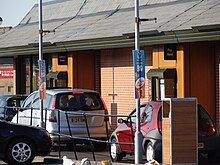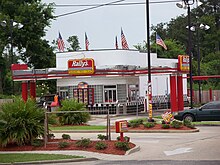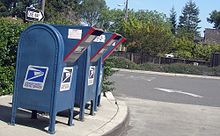
Back طلبات السيارة Arabic Bestèl-mè'rad BEW Drive thru-restaurant Danish خدمات سواره Persian Drive (commerce) French דרייב ת'רו HE Lantatur ID Drive-through Italian ドライブスルー Japanese 드라이브스루 Korean



A drive-through or drive-thru (a sensational spelling of the word through), is a type of take-out service provided by a business that allows customers to purchase products (or use the service provided by the business) without leaving their cars. The format was pioneered in the United States in the 1930s, and has since spread to other countries.
Drive-through facilities typically come in one of three forms. 1. Single lane, where the agent is in the kiosk on the driver's side; 2. Dual lane, with the left lane on the left side of the kiosk facing the right side of the vehicle, and the right lane on the right side of the kiosk, facing the left side of the vehicle, with either an agent for each lane or a single agent handling both lanes; and 3. multilane, with two or more lanes all with an agent on the driver's side of the vehicle. In some cases, a single lane kiosk may be approached in either direction at the driver's choice as to whether the driver or the passenger interacts with the agent.
A drive-up window teller was installed at the Grand National Bank of St. Louis, Missouri, in 1930. The drive-up teller allowed only deposits at that time.[1]
Orders are generally placed using a microphone and picked up in person at the window. A drive-through is different from a drive-in restaurant in several ways - the cars create a line and move in one direction in drive-throughs, and normally do not park, whereas drive-ins allow cars to park next to each other, the food is generally brought to the window by a server, called a carhop, and the customer can remain in the parked car to eat. However, during peak periods, to keep the queue down and avoid traffic flow problems, drive-throughs occasionally switch to an "order at the window, then park in a designated space" model where the customer will receive their food from an attendant when it is ready to be served. This results in a perceived relationship between the two service models.
Drive-throughs have generally replaced drive-ins in popular culture, and are now found in the vast majority of modern American fast food chains. Sometimes, a store with a drive-through is referred to as a "drive-through", or the term is attached to the service, such as, "drive-through restaurant". or "drive-through bank".
Drive-throughs typically have signs over the drive-through lanes to show customers which lanes are open for business. The types of signage used is usually illuminated so the "open" message can be changed to a "closed" message when the lane is not available.
- ^ "Popular Mechanics". Books.google.com. Hearst Magazines. July 1930. p. 13. Retrieved June 2, 2016.